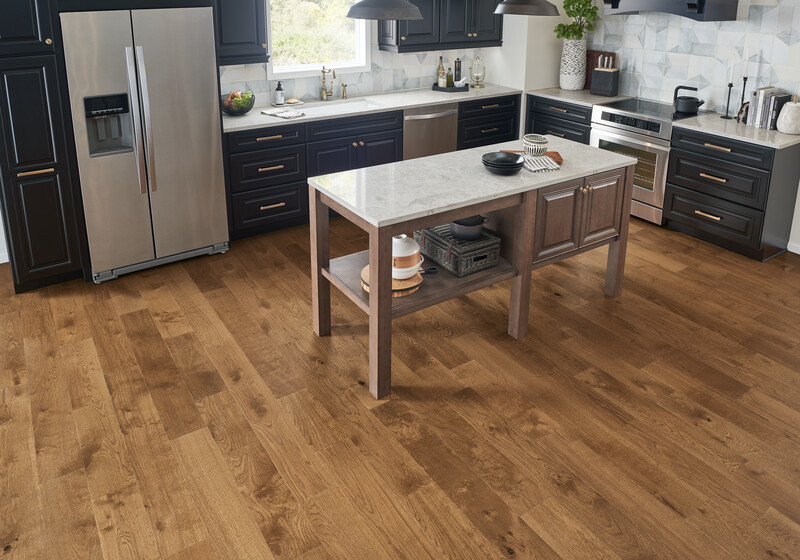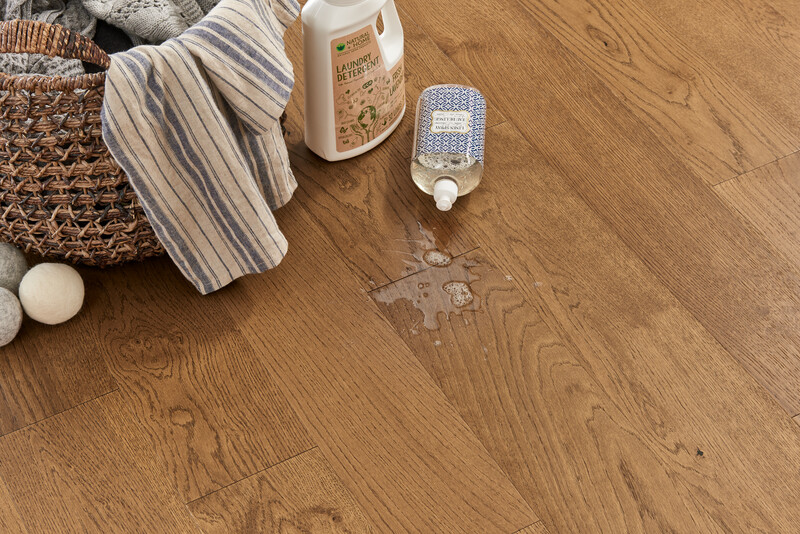Engineered Wood Flooring – Perfect for Kitchens
Kitchens are the heart of the home and one of the busiest areas in the house. That’s why choosing the right flooring for kitchens means balancing durability, design, and moisture resistance. Many homeowners love the warm, classic look of solid wood. However, they worry about how it will withstand the rigors of a bustling kitchen.
Well, there’s no need to worry. Engineered hardwood provides the perfect solution for high-traffic areas, such as kitchens. You get the natural beauty of hardwood with improved performance.

What Is Engineered Hardwood Flooring?
Unlike solid hardwood planks, engineered hardwood flooring uses a layered approach. The core is made with plywood or high-density fiberboard (HDF). However, the top layer features genuine hardwoods, such as oak, maple, or hickory.
The benefit? Engineered hardwoods are less prone to warping or expanding than solid hardwood flooring. So they can handle temperature and humidity changes, as well as splashes, much better. And those are all pluses for a kitchen.
No Sacrifices on Style
Best of all, you get the performance benefits without sacrificing the allure of genuine hardwoods. Select your preferred species, add some hand-scraping, and pick your color. Engineered hardwood is in no way lacking in style.
You can easily coordinate your kitchen flooring with the cabinetry, backsplash tile, or countertops to create a cohesive look. And guess what? Unlike luxury vinyl tiles or laminate, no one will ever question whether your floors are hardwood.
Why Engineered Wood Works So Well in Kitchens
Kitchens demand more from flooring than almost any other room in your home. Spills, heat, foot traffic, and dropped utensils are part of daily life, making durability and moisture resistance must-haves. Engineered wood for kitchen flooring is a reliable and innovative choice.
Here’s how it rises to the challenge:
- Moisture Resistance: The layered core resists water damage more effectively than solid wood, making it a more forgiving option in spill-prone areas.
- Durability: Many engineered hardwood floor products have durable finishes. These help resist scratches, dents, and stains from daily wear and tear.
- Versatility: Engineered hardwoods can be installed over concrete or on top of radiant heat systems. This makes installation simpler and adds to their appeal in kitchen remodels.
The bottom line? Engineered wood for kitchen flooring offers the look of traditional timber with added resilience, making it ideal for busy, high-traffic kitchens.

Maintenance Made Simple
Keeping your engineered wood floor looking its best is relatively low effort:
- Regular sweeping or vacuuming keeps dirt and grit from scratching the surface.
- Damp mopping with a wood-safe cleaner helps maintain shine without oversaturating the floor.
- Use mats near the sink and stove to protect against spills and dropped utensils.
- Avoid steam or wet mops—excess moisture is still the enemy, even with improved water resistance. Engineered wood is water-resistant, not waterproof. Robbins® has a waterproof offering with its HydroGuard® engineered hardwood.
You also get one other benefit from engineered hardwoods in kitchens. You can sand and refinish them, provided the top layer is thick enough to withstand the process. So, if your floors succumb to daily wear and tear, you can refinish them instead of replacing them.
Key Considerations Before Installing Engineered Hardwoods
Engineered wood is tough, but not indestructible. Before choosing it as your kitchen flooring, consider the following:
- Opt for higher-end products with water-resistant cores and durable finishes. A thicker hardwood veneer is also a plus for refinishing purposes.
- Choose professional installation if you’re not experienced—installing over uneven subfloors can affect the longevity of your flooring.
- Based on your subfloor and the available space, select an appropriate installation method: floating, glue-down, or nail-down.
- Understand the limitations. While engineered wood can handle daily kitchen life, standing water or prolonged leaks can still cause damage.
How Engineered Wood Compares to Other Kitchen Flooring Options
| Flooring Type | Pros | Cons |
| Engineered Wood | Natural wood look, stable, stylish | Sensitive to moisture if not cleaned up quickly |
| Tile | Water-resistant, durable | Hard and cold underfoot, louder |
| Vinyl or LVT | Waterproof, affordable, and easy to maintain | Lacks the authenticity of real wood |
| Solid Hardwood | Can be refinished many times, beautiful | Warps or cups in high-moisture areas |
Among all flooring options, engineered wood offers the perfect middle ground between style and performance in the kitchen.
Is Engineered Wood Flooring Right for Your Kitchen?
Engineered wood is a standout choice for adding warmth and sophistication to your kitchen floor. It handles daily wear and tear, looks beautiful, and offers more moisture resistance than traditional hardwood.
Discover the ideal engineered hardwood for your kitchen at Robbins. They have over 100 offerings in a range of styles and finishes. Choose from ash, cherry, hickory, maple, pine, walnut, and oak. Distressed and wire-brushed finishes, along with wide planks, add even more character to your flooring.
Engineered wood flooring for kitchens meets the needs of today’s busy, design-savvy households. Robbins offers a variety of styles. Find a Robbins dealer near you.
